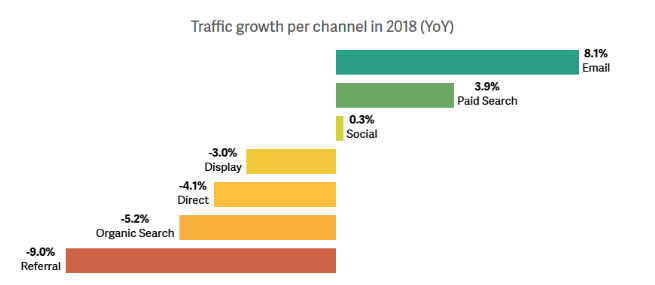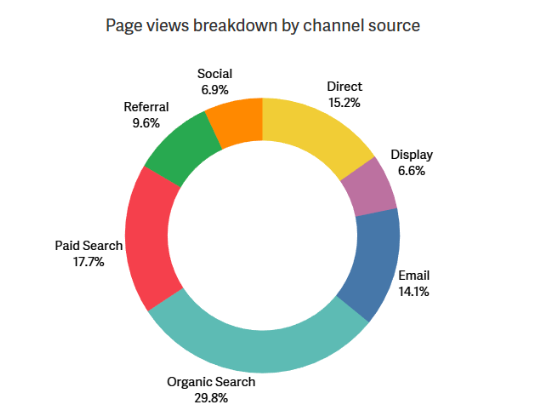
73 percent of marketers rate email as the number one digital channel for ROI according to the last Email Marketing Industry Census 2018 from Econsultancy and Adestra. From 2016 to 2018, 21.5 percent of sales were attributed to the email marketing channel while email was capped at 15 percent of total marketing budgets.
The latest marketing trends have driven a number of companies to engage in the newest methods of marketing, like viral marketing efforts, through social media in order to reach customers. In this context, email has often been underestimated as a key and strategic channel to generate highly qualified website traffic.
The greatest challenge for modern marketers is determining which channels to invest in. In order to determine which channels marketers need to invest in more, I used Google Analytics’ benchmarking reports to evaluate how each channel contributes to driving website traffic and engagement. By evaluating the traffic of over 32,000 shopping websites, I was able to identify four facts about how email contributes to online business.
1. The email channel contribution to shopping website traffic substantially increased in 2018
The year over year growth per channel in terms of sessions reveals an amazing uplift for the email channel. The number of sessions coming from the email channel rose by over eight percent in 2018 compared to 2017.
2. In 2018, 14 percent of the pageviews relied on visits coming from the email channel.
Shopping website visits are largely supported by the email channel. We identified that over 14 percent of website pageviews were coming through the email channel along with approximately 10 percent of the user sessions (similar to user visits). The average number of pages per session from email is higher than any other.
3. Visits from the email channel generate the highest engagement level.
Visitors coming from the email channel are much more engaged with website content with an average of 5.5 pages per session in 2018. As a comparison, user sessions coming from this channel generates 34 percent more page views per session than the social channel.
The bounce rate here is a web analytics measure that highlights the percentage of users leaving the website after a single-page session. With just a 38 percent bounce rate, the email channel is once again the top performing channel.
4. Email is definitely the best channel to drive retention.
71 percent of users coming from the email channel are returning visitors. This puts the email channel as the #1 channel to bring back loyal clients and visitors. Google’s definition for returning users rate is the percentage of users visiting the website content multiple times with a device or a browser.
This research highlights how unique the email channel is when we look at the online behaviors for these users. While the email channel is the fourth channel in terms of online sessions for shopping websites, the quality and level of engagement from these users is noteworthy.
As a conclusion, while websites benefit from all the channels traffic, email should never be under-estimated when it comes to generate user engagement and client retention. The gap between email-driven revenue and investment in the channel has widened considerably over the past years*. Whatever the reason of the current marketing budget breakdown is, marketers are missing a key growth opportunity by underestimating email.
Methodology:
This research relies on Google Analytics benchmarking data for the “shopping” vertical in 2018. Websites with traffic from 500 to 10,000 daily sessions have been included. The channel selection voluntary excludes “other advertising” and “Others” values to focus on the most common channels.
Quick tip: Google Analytics users can easily compare their own performances against the benchmark from their industry, location, and daily sessions range. The benchmarking report is accessible and updated on a daily basis.




